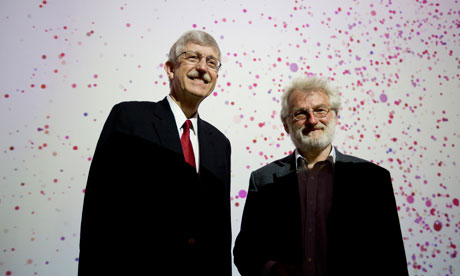John Sulston, who led the UK branch of the Human Genome Project, says patents on human genes would restrict access to treatments and inhibit research

John Sulston (right) and Francis Collins at London’s Science Museum today to mark the 10th anniversary of the first draft from the Human Genome Project. Photograph: Martin Argles/Guardian
Human genetic information must be kept in the public domain to allow researchers to analyse it and to give members of the public fair access to medical treatments, the Nobel prizewinning scientist who led the British contribution to the Human Genome Project said today.
Speaking at a briefing at the Science Museum in London to mark the 10th anniversary of the first draft of the human genome, biologist John Sulston said scientists and lawmakers must resist attempts by corporations and individuals to patent human genes.
In the US, for example, it costs a woman between $3,000 and $4,000 to be tested for familial breast cancer because a corporation owns the patent for the two genes involved. “The fact of the matter is that many human genes have patent rights on them and this is going to get in the way of treatment unless you have a lot of money,” said Sulston. “And it’s going to get in the way of research.”
Sulston said he was particularly concerned about the intentions of scientists such as Craig Venter, who made headlines earlier this month when he unveiled work described in the media as “the world’s first artificial life form”.
Sulston said Venter’s work was “clever and pretty” but was not artificial life. “What that advance is being used for is an attempt to monopolise, through the patenting system, essentially all the tools for genomic manipulation,” he said. “Let’s be clear that the tools for manipulating genomes should be in the public domain. This is not just a philosophical point of view, it’s actually the case that monopolistic control of this kind would be bad for science, bad for consumers and bad for business, because it removes the element of competition.”
Before the human genome project completed its first draft in 2000, Sulston had fought to keep the genome data freely accesible to researchers around the world. At the same time, Craig Venter was racing to sequence the human genome through his company, Celera, with the intention of charging reseachers for access to the information. In 2000, the two sides brokered a deal through the mediation of the UK and US governments and the human genome was put in the public domain.
To mark the 10th anniversary of the first draft of the human genome, Mike Stratton, director of the Wellcome Trust Sanger Institute in Cambridge, unveiled a £10.5m plan to sequence the genomes of 10,000 people in the UK.
“Over the past decade, we have found hundreds of common variants that each make a small difference to many diseases, but we still have to explain much of the genetic basis of most diseases,” he said. “One promising source of additional genetic contribution is in rarer variants which each confer greater risks of disease. It took 13 years to sequence the first genome. Now we sequence several human genomes every few days.”
He said the UK 10,000 Genomes Project would search for these rarer variants and take advantage of the new technology to discover the contribution they make to health and disease.
Around 4,000 genomes will be sequenced from healthy people who are already part of large-scale project to monitor a range of biological and health factors such as height and weight. Their genetic data will be compared with genome sequences from 6,000 people who have specific disorders including severe obesity, autism, schizophrenia or congenital heart disease.
The 10,000 Genomes Project has become possible thanks to the rapid pace of improvement in gene sequencing technology. “We can now study the genome sequences of 10,000 people in three years,” said Mark Walport, director of the Wellcome Trust. “Just a decade ago it took much more time and money to decode just a single sequence. The involvement of clinicians, researchers and, most importantly, the thousands of people who have donated DNA samples, will help us to correlate genetic variation with individual variation in health and disease, and help to deliver on the long-term promise of the human genome project.”
The Science Museum was marking the 10th anniversary of the first draft with the launch of its new Who am I? gallery.



